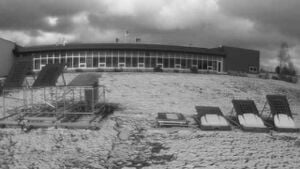
Assessing snow-related energy losses is necessary for accurate predictions of photovoltaic (PV) performance. A PV test platform with seven portrait-oriented modules placed at four tilt angles (0°, 15°, 30°, and 45°) was installed in Calumet, MI, USA, to measure the energy loss in this snowy climate. As a best-case snow-shedding configuration, similar to a carport or a plain sloped roof, three of the test modules were rack-mounted high enough to prevent surface interference. The opposite effect of maximum surface interference, similar to many commercial rooftops, was introduced by mounting the other four modules at grade. The platform was monitored for one year beginning in October 2013. The snowfall that winter was normal: 5.3 m (209 in). Snow-related annual energy losses ranged from 5% to 12% for the elevated unobstructed modules, with the steepest tilt angle experiencing the least amount of energy loss. For the obstructed modules, there was little angular dependence on lost energy, with annual energy losses ranging from 29% to 34%. This relative three- to sixfold increase in lost energy when ground interference is present points out the importance of minimizing obstructions and prompt snow clearing for portrait-oriented PV. Depending on the breadth of an inverter's operating voltage limits, these results suggest that landscape-oriented array layouts and perhaps snow-clearing mechanisms may be advantageous in snowy climates.
See also[edit | edit source]
- Details on PV performance monitoring by R. Andrews. PV Performance Modeling: Assessing Variability, Uncertainty and Sensitivity. Solar Professional Issue 8.5, Sep/Oct 2015.
- "The 10 Snowiest Places on the Planet" by the Mother Nature Network.
Related Pages[edit | edit source]
- The Impact of Snow Losses on Solar Photovoltaic Systems in North America in the Future
- Snow Losses for Photovoltaic Systems: Validating the Marion and Townsend Models
- Image Analysis Method for Quantifying Snow Losses on PV Systems
- Performance of Bifacial Photovoltaic Modules on a Dual-Axis Tracker in a High-Latitude, High-Albedo Environment
- Differences in Snow Shedding in Photovoltaic Systems with Framed and Frameless Modules
- Effects of snow on photovoltaic performance
- Open Solar Outdoors Test Field
- Outdoor data acquisition
- Queen's Innovation Park Test Site
- Solar resource measurement for PV applications
- Prediction of energy effects on photovoltaic systems due to snowfall events
- A new method to determine the effects of hydrodynamic surface coatings on the snow shedding effectiveness of solar photovoltaic modules
- Monofacial vs bifacial solar photovoltaic systems in snowy environments
- A Review of the Effects of Haze on Solar Photovoltaic Performance





